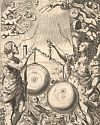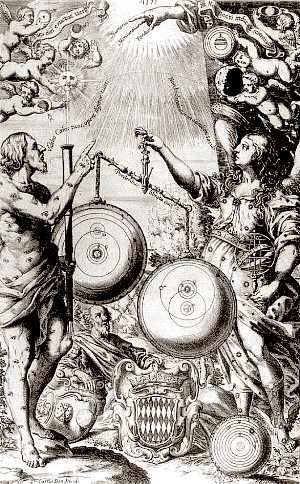
|
Giovanni Riccioli
(17 Apr 1598 - 25 Jun 1671)
Italian astronomer.
|
Giovanni Riccioli
from Penny Cyclopaedia of the Society for the Diffusion of Useful Knowledge (1841)
 Frontispiece from Almagestum novum (1651).
The image portrays Urania, the muse of astronomy, weighing up the rival
systems of Copernicus, in which the earth moves round the sun, and
Riccioli himself, in which the earth remains stationary at the center
of the universe. The older system of Ptolemy has already been discarded
and lies on the ground alongside.
Frontispiece from Almagestum novum (1651).
The image portrays Urania, the muse of astronomy, weighing up the rival
systems of Copernicus, in which the earth moves round the sun, and
Riccioli himself, in which the earth remains stationary at the center
of the universe. The older system of Ptolemy has already been discarded
and lies on the ground alongside.His first published work was the ‘Almagestum novum’ (1653), which constitutes a treatise on astronomy. In it he mentions the origin of the science, and gives a list of those who had cultivated it: he also describes his method of measuring a degree of the earth's surface, and a pendulum of his own invention. He computes the obliquity of the ecliptic, the length of the tropical year, and the elements of the orbits of the sun, moon, and planets; he also treats of eclipses, and gives a long list of such as had been observed from the earliest time. The work contains a treatise on parallaxes, and some ideas of the writer concerning the body of the moon.
The learned world was then divided between the followers of Aristotle and the disciples of Copernicus in their opinions respecting the system of the universe. In the ‘Almagestum,’ Riccioli, having explained the ideas of the last-mentioned philosopher concerning the movement of the earth, offers a long series of objections to them, which, with a brief reply to each, may be seen in Delambre (Histoire de l'Astron. Mod., tom, i., p. 672, &c). He acknowledges however that the more we examine the hypothesis of the earth's several motions, the more we must admire the genius and sagacity of Copernicus, who had been able to explain so simply the phenomena of the heavens; and he expresses his regret that the fruits of a brilliant imagination should be set forth as realities. The admiration constantly expressed for Copernicus, and even the manner in which the objections to his theory are stated, have led to a belief that this learned Jesuit was a Copernican in his heart; and, from a passage in the work, it appears that the Aristotelians and theologians of that day, in their opposition, were more afraid of the consequences of making concessions in favour of a theory which seemed to them to be at variance with the letter of the Scriptures, than inimical to the theory itself.
The ‘Almagestum’ contains many passages which betray the prejudices of the age. As a reason for the necessity of reforming the calendar, Riccioli asserts that the blood of St Januarius continued to liquefy on the 19th of September, though the time of the equinoxes had been anticipated by ten days: he finds several causes for the supposed eclipse of the sun which took place at the death of Christ, and be dwells at some length upon those which, it has been imagined, will immediately precede the end of the world.
In 1661 Riccioli published a work on geography and hydrography, in which is given an account of the operations which, in conjunction with P. Grimaldi, he had carried on in order to determine the length of a degree of the terrestrial meridian. For this purpose a base-line was measured near Bologna, and a triangulation was formed between that city and Modena; the stations appear however to have been improperly chosen, for the angles between them are often less than eight degrees, and only two were observed in each triangle. The instrument employed for obtaining the terrestrial angles was similar to the parallactic rulers of Ptolemy; and, in reducing the distances between the stations to one spherical surface, Riccioli assumed the refraction as constant, and equal to thirty minutes, as it had been determined by Tycho Brahe for celestial bodies in the horizon. The latitudes of the stations were determined by the sun and certain stars, their altitudes being observed with a quadrant whose radius was eight feet; but the declinations were taken from the catalogue of the astronomer just mentioned, and consequently were liable to errors amounting to one minute or more. It appears also that Riccioli entertained an opinion that the measures of the ancients were nearly correct; hence, among his observations, he made choice of such as gave results which approached the nearest to those measures, and thus his determination of the length of a degree is found to have been very erroneous. The value expressed by 64,365 paces of Bologna (= 66,772 Eng. fath.), which he obtained by one of his methods, is considered by him as possessing an evidence in its favour which nothing can resist; it however differs far more from the truth than the determination of Snell, which had been made a few years previously in France; and in fact it is too great by above 6000 fathoms. The same work contains some remarks on the variation of the magnetic needle, observations on geographical longitudes and latitudes, and several problems relating to navigation.
Lastly, in 1665, Riccioli published his ‘Astronomia Reformata,’ a work in which he treats of refractions and parallaxes, and describes the instruments which he used to determine (he places of the stars. He also gives a collection of the observations previously made on the planets, and he compares them with the astronomical tables which had then been published. The work concludes with several tables relating to chronology, geography, and astronomy, and with a catalogue of stars.
This writer, who is considered as having been less useful to mankind by
his discoveries than by the care which he took to record those of his
predecessors, died in 1671, at the age of seventy-three years.
 17 April
- short
biography, births, deaths
and events on date of Riccioli's date of birth.
17 April
- short
biography, births, deaths
and events on date of Riccioli's date of birth.





